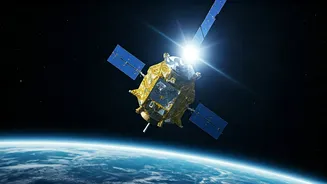Early Ambitions and Goals
Blue Origin was established with the ambitious goal of making space accessible to everyone. The founder, Jeff Bezos, envisioned a future where millions
of people would live and work in space, and the company has been consistently working towards that. It aims to reduce the cost of space travel, thereby opening up opportunities for research, tourism, and resource utilization. The company's long-term vision includes establishing a sustained human presence in space, contributing to scientific advancement and the expansion of the human frontier. They are actively engaged in developing reusable rockets and spacecraft to minimize costs and environmental impact, which aligns with their commitment to making space travel sustainable. Blue Origin is also investing in infrastructure projects, such as spaceports and landing facilities, to support these endeavors. They are not only striving to revolutionize how humans reach space but also how they interact with it, creating a more dynamic and accessible future for all.
New Shepard's Journeys
The New Shepard suborbital rocket system has been a cornerstone of Blue Origin's achievements. Named after astronaut Alan Shepard, the New Shepard has undertaken numerous successful flights, carrying both payloads and humans into space. Each launch represents a step forward, gathering crucial data on spaceflight systems. The reusability of the New Shepard booster is one of its most remarkable features, landing vertically after its ascent, decreasing the cost of each mission. During its flights, it provides passengers and experiments with a few minutes of weightlessness. This offers a unique opportunity to experience space, contributing to scientific studies. The vehicle’s safety record and consistent performance has played a key role in building confidence in Blue Origin's capabilities. With each launch, it contributes to valuable insights, propelling both technological advancement and the possibility of future human spaceflight.
Orbital Rocket Development
The development of the New Glenn orbital rocket marks another significant step for Blue Origin. Unlike the suborbital New Shepard, New Glenn is designed to carry payloads and humans to orbit. This is a much more complex endeavor, calling for greater thrust, size, and efficiency. Blue Origin has invested significant resources and time to design a rocket capable of competing in the global launch market. The New Glenn aims to provide competitive access to space, serving satellite operators, governments, and scientific organizations. The rocket is equipped with a reusable first stage, which should reduce overall launch costs. This development aligns with Blue Origin's vision for making space access more affordable. The company anticipates numerous applications of New Glenn, ranging from launching communications satellites to supporting missions to the Moon and beyond. The New Glenn rocket's development showcases Blue Origin’s aspirations to participate extensively in the space economy.
Space Exploration Beyond Earth
Blue Origin's ambitions go beyond suborbital flights and orbital launches; they are actively working on projects aimed at exploring the Moon and other celestial bodies. The Blue Moon lunar lander is one of the most prominent of these projects. Designed to transport cargo and humans to the lunar surface, Blue Moon reflects the company’s strong commitment to supporting NASA's Artemis program. Blue Origin's aim is to foster long-term human presence on the Moon, providing infrastructure and technologies needed for lunar exploration. This includes developing essential systems like propulsion, landing, and life support. Furthermore, they are involved in partnerships and collaborations with other space agencies and companies to pool resources and share expertise. Their work on lunar exploration signifies an important element in the global efforts to understand and utilize resources in space.
Technological Advancements
At the core of Blue Origin's achievements are its technological innovations. They have pioneered advancements in rocket engines, composite materials, and reusability. The BE-4 engine, developed by Blue Origin, represents an important achievement in propulsion technology. The BE-4 is designed to use liquefied natural gas (LNG) as fuel, providing increased efficiency and reduced environmental impact. Furthermore, Blue Origin's investment in advanced manufacturing techniques, such as 3D printing, enables them to rapidly prototype and produce rocket components. The company's focus on reusability, particularly in its rocket designs, minimizes expenses and accelerates space travel. These developments drive down the cost of launches and encourage commercial and scientific endeavors in space. Blue Origin continuously invests in research and development to remain at the leading edge of space exploration technology.
Impact and Future Prospects
Blue Origin's achievements are influencing the space industry and shaping the future. The company is promoting a new era of space travel by reducing costs and increasing accessibility. Through its innovative projects, it’s also contributing to the growth of a space-based economy. These accomplishments have spurred interest from both private companies and government agencies, generating collaborations and partnerships. Blue Origin’s contribution is also helping to drive education and inspire a new generation of scientists and engineers. Looking ahead, Blue Origin has the potential to contribute to a wide array of activities, including space tourism, resource exploitation, and scientific discovery. They are actively laying the groundwork for a future where space exploration is an integral part of human activities. Their long-term vision is to establish a sustained human presence in space, expanding the human footprint into the cosmos.














